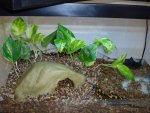yager
Member
- Joined
- May 5, 2008
- Messages
- 63
- Reaction score
- 0
- Points
- 6
- Location
- Kansas City, Missouri
- Country
- United States
Hey guys i posted pics of my female back in june with the flesh eating disease and am pleased that she has recovered so well (neosporine works wonders) thanks for the tips. I was keeping the pair in plastic tubs seperated with paper towels as substrate but got tired of the constant cleaning. I have moved them to a more naturlaistic enclosure with pothos growing in gravel today. There is a pump in the water that moves it back to the land area. I have read that the pothos roots act as a type of filter for nitrate build up and helps keep the water cleaner. I realize that i will still have to do partial water changes but was wondering if you guys think this idea will work and help cut down on maintenance. Here are some pics just after setup.



